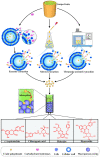Comprehensive Utilization of Thinned Unripe Fruits from Horticultural Crops
- PMID: 34574153
- PMCID: PMC8467360
- DOI: 10.3390/foods10092043
Comprehensive Utilization of Thinned Unripe Fruits from Horticultural Crops
Abstract
Fruit thinning is a cultivation technique that is widely applied in horticulture in order to obtain high-quality horticultural crops. This practice results in the discarding of a large number of thinned unripe fruits in orchards each year, which produces a great waste of agricultural resources and causes soil pollution that may be an important reservoir for pest and plant diseases. Current studies showed that bioactive compounds such as polyphenols, organic acids, monosaccharides and starches are present in unripe fruits. Therefore, we reviewed the bioactive components obtained from thinned unripe fruits, their revalorization for the food industry, their beneficial effects for human health and the methods for obtaining these components. We also performed a calculation of the costs and benefits of obtaining these bioactive compounds, and we proposed future research directions. This review provides a reference for the effective utilization and industrial development of thinned unripe fruits obtained from horticultural crops. Furthermore, revalorizing the waste from this cultural practice may increase the economic benefits and relieve the environmental stress.
Keywords: comprehensive utilization; horticultural crops; non-phenolic bioactive compounds; phenolic bioactive compounds; thinned unripe fruits.
Conflict of interest statement
The authors declare that they do not have any conflict of interest.
Figures






References
-
- Ouma G. Fruit thinning with specific reference to citrus species: A review. Agric. Biol. J. N. Am. 2012;3:175–191. doi: 10.5251/abjna.2012.3.4.175.191. - DOI
-
- Frioni T., Zhuang S., Palliotti A., Sivilotti P., Falchi R., Sabbatini P. Leaf removal and cluster thinning efficiencies are highly modulated by environmental conditions in cool climate viticulture. Am. J. Enol. Vitic. 2017;68:325–335. doi: 10.5344/ajev.2017.16098. - DOI
-
- Byers R.E. Apples Botany Production & Uses. Department of Horticulture, Virginia Polytechnic Institute and State University; Winchester, VA, USA: 2003. Flower and fruit thinning and vegetative: Fruiting balance. - DOI
-
- Greene D., Costa G. Fruit thinning in pome- and stone-fruit: State of the art. Acta Hortic. 2013:93–102. doi: 10.17660/ActaHortic.2013.998.10. - DOI
-
- Yeshitela T., Robbertse P.J., Fivas J. Effects of fruit thinning on ‘sensation’ mango (Mangifera indica) trees with respect to fruit quantity, quality and tree phenology. Exp. Agric. 2004;40:433–444. doi: 10.1017/S0014479704002091. - DOI
Publication types
Grants and funding
LinkOut - more resources
Full Text Sources

